SAFE SEAS INTERNATIONAL INC. PROPRIETARY OIL RECORD BOOK


SAFE SEAS INTERNATIONAL INC. PROPRIETARY OIL RECORD BOOK ENTRIES HOW TO STAY OUT OF TROUBLE !

SAFE SEAS INTERNATIONAL INC. PROPRIETARY THE OIL RECORD BOOK The single most important document on board for verifying that the vessel is in compliance with international anti pollution regulations is the OIL RECORD BOOK. The importance of this book, and the accuracy within, can not be overemphasized.

SAFE SEAS INTERNATIONAL INC. PROPRIETARY “Cradle to Grave” describes the record keeping requirements regarding oil and bilge water . Oil must be accounted for from the time it comes aboard in the form of bunkers or lubes, until the time it is disposed of, either transferred to another tank, ashore to reception facilities, or burned in an incinerator (if fitted). About the only accounting you don’t have to include in the Oil Record Book is how much oil or lubes were consumed by normal usage!

SAFE SEAS INTERNATIONAL INC. PROPRIETARY Bilge water must be accounted for from the time it is drawn from any bilge well until the time it is disposed of. Bilge water may be disposed of either overboard through an approved OWS, ashore to reception facilities, or on some tankers, they can be pumped to cargo slop tanks. We’ll talk about specific entries required in a moment, but first…..

SAFE SEAS INTERNATIONAL INC. PROPRIETARY THE FIRST LINE OF DEFENSE The Oil Record Book (ORB) is your “first line of defense”. This is the most important record that any Port State Control Officer (PSCO) or USCG inspector will utilize to determine whether you and your vessel are in compliance with applicable regulations. This is the USCG’s first stop on its investigative path to ensure that your vessel is in compliance.

SAFE SEAS INTERNATIONAL INC. PROPRIETARY ANY irregularity or inaccuracy is viewed with suspicion, and will inevitably lead to a much closer examination of the vessel in general and machinery spaces in particular. While “ignorance may be bliss” for some, a more accurate quote is that “ignorance is no excuse before the law”! As a Licensed Officer whose professional career may indeed depend on it, you MUST take the time to familiarize yourself with the instructions contained within the ORB. You MUST check and recheck your information for accuracy BEFORE you make an entry in the ORB.
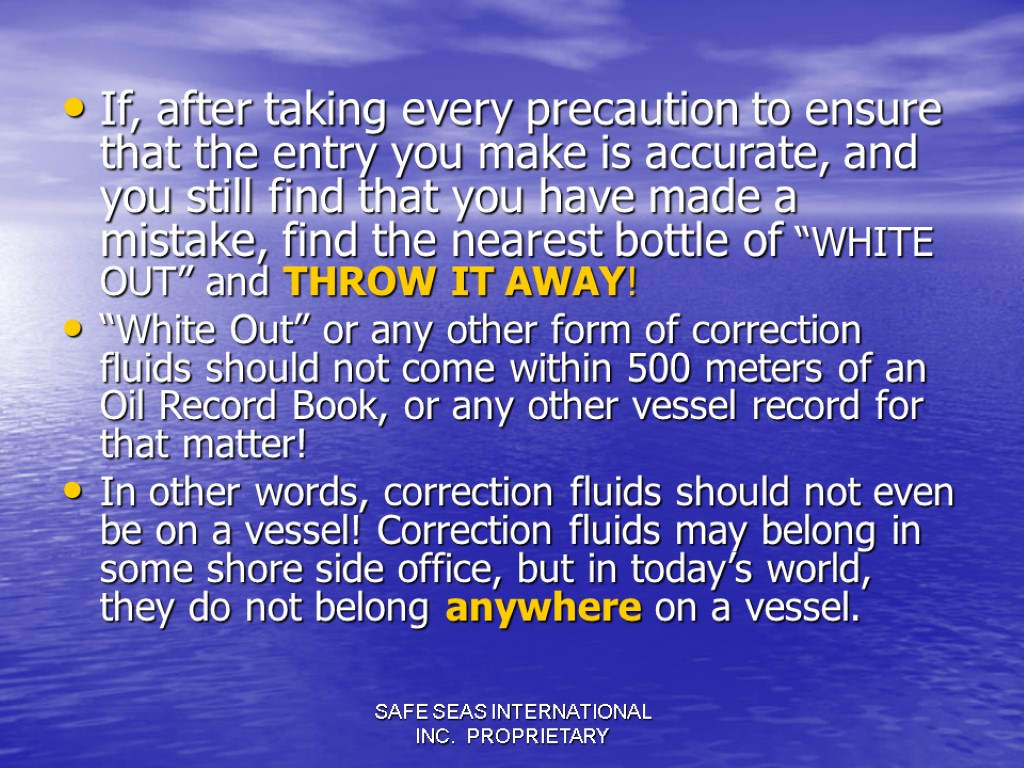
SAFE SEAS INTERNATIONAL INC. PROPRIETARY If, after taking every precaution to ensure that the entry you make is accurate, and you still find that you have made a mistake, find the nearest bottle of “WHITE OUT” and THROW IT AWAY! “White Out” or any other form of correction fluids should not come within 500 meters of an Oil Record Book, or any other vessel record for that matter! In other words, correction fluids should not even be on a vessel! Correction fluids may belong in some shore side office, but in today’s world, they do not belong anywhere on a vessel.

SAFE SEAS INTERNATIONAL INC. PROPRIETARY If you do make a mistake, there is one, and only one universally and legally accepted method of correction to official documents, including the ORB. Make a strike through the incorrect entry, and initial and date the strike through. This must be immediately followed by the correct (amended) entry. Finally, each entry in the Oil Record Book must be signed and dated by the Officer who conducted the Operation .
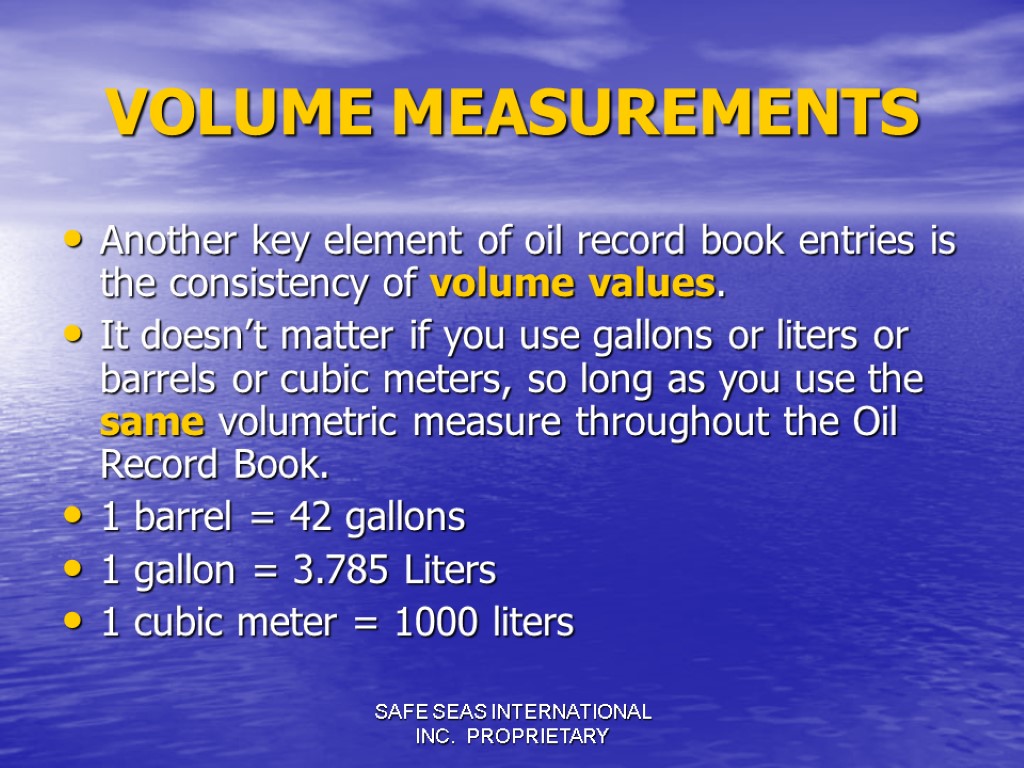
SAFE SEAS INTERNATIONAL INC. PROPRIETARY VOLUME MEASUREMENTS Another key element of oil record book entries is the consistency of volume values. It doesn’t matter if you use gallons or liters or barrels or cubic meters, so long as you use the same volumetric measure throughout the Oil Record Book. 1 barrel = 42 gallons 1 gallon = 3.785 Liters 1 cubic meter = 1000 liters
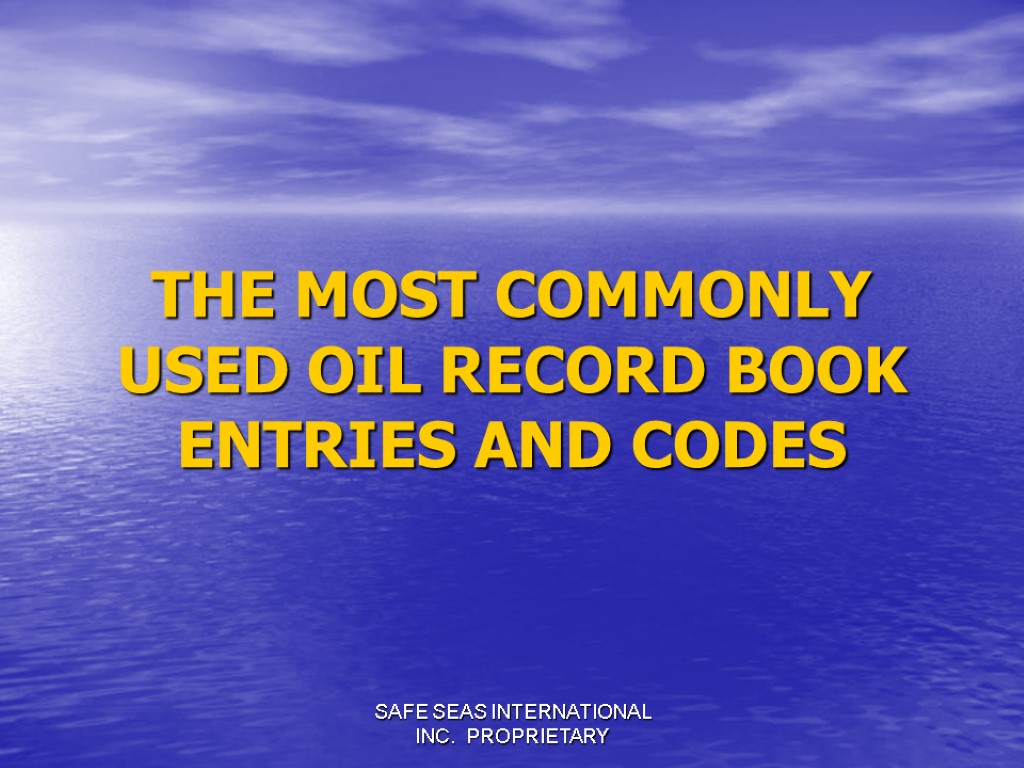
SAFE SEAS INTERNATIONAL INC. PROPRIETARY THE MOST COMMONLY USED OIL RECORD BOOK ENTRIES AND CODES

SAFE SEAS INTERNATIONAL INC. PROPRIETARY The list of items to be recorded in the Oil Record Book are quite long, and include code letters from (A) to (I). However, the most commonly used Oil Record Book entry codes used in the ORB Part 1 Machinery Spaces are:

SAFE SEAS INTERNATIONAL INC. PROPRIETARY Code letter (C): Collection And Disposal Of Oil Residues (Sludge, waste oil, used oil etc.) Code letter (D): Non Automatic Discharge Overboard Or Disposal Otherwise Of Bilge Water Which Has Accumulated In Machinery Spaces Code letter (H): Bunkering Of Fuel Oil Or Bulk Lubricating Oil

SAFE SEAS INTERNATIONAL INC. PROPRIETARY It is the PROFESSIONAL and LEGAL responsibility for each officer to be familiar with the Oil record book, its required entries, and the appropriate code letters. PROFESSIONAL is the part where you could lose your job and perhaps your license if you don’t get it right. LEGAL is the part where, if you don’t get it right, you could be fitted with handcuffs, and or pay fines OUT OF YOUR OWN POCKET!) We’ll only address the most common ones used by Engine Room Personnel. These are “C”, “D”, and “H”.

SAFE SEAS INTERNATIONAL INC. PROPRIETARY (H) BUNKERING OF FUEL OIL OR BULK LUBRICATING OIL In keeping with our “cradle to grave” analogy for record keeping, we’ll start with ORB entries for bunkering. The requirements for making ORB entries regarding bunkering are pretty straight forward. They have been in place for many years. Engineers should be familiar with the ORB Part 1 code letter “H”.

SAFE SEAS INTERNATIONAL INC. PROPRIETARY H - 27.1 Place of Bunkering There are no points awarded for shorthand! Be Specific! Include the actual location, such as the terminal, and the port. For example, “Berth # 2, Conoco Bayway plant, Bayway, NJ is CORRECT. Simply saying “Bayway, NJ”, is INCORRECT! Be Specific. There are no points awarded for shorthand!

SAFE SEAS INTERNATIONAL INC. PROPRIETARY H-27.2 Time of Bunkering. This MUST include both start and stop times. These “start” and “stop” times should also match the time you have recorded on the bunkering D.O.I. H-27.3 Type and Quantity of FUEL OIL and identity of tank(s), stating quantity added and total content of tank(s) For the TYPE of fuel, be specific. If it’s # 2 fuel oil, say that. If it’s MDO, say that! If it’s IFO 380, say that! Regarding Quantity of fuel: if you took 10,000 gallons / tons / barrels of fuel (whichever measurement you use onboard), split to 2 different tanks, then record how much fuel you added to EACH tank. And when you are finished topping off, state how much fuel is in EACH tank!

SAFE SEAS INTERNATIONAL INC. PROPRIETARY H-27.4 Type and Quantity of LUBRICATING OIL and identity of tank(s), stating quantity added and total content of tank(s) Follow the same procedures for 27.4 as you do for 27.3, but remember! 27.3 is for FUEL, and 27.4 is for lubes! TAKE THE TIME TO CODE IT CORRECTLY! Last but not least, when you are finished and have made the required entry, SIGN THE ENTRY!! EVERY ENTRY IN THE OIL RECORD BOOK MUST BE SIGNED (NOT INITIALED) BY THE OFFICER IN CHARGE OF THE OPERATION!

SAFE SEAS INTERNATIONAL INC. PROPRIETARY (C) COLLECTION AND DISPOSAL OF OIL RESIDUES (sludge & waste oil) The Oil Record Book, Part 1, Code Letter “C” is divided into two categories, including “Collection” (C-11) and “DISPOSAL (C-12). C-11 is further divided into two “sub categories” which are: C-11.1 - This code is for waste or sludge that is a direct result from the purification of fuel or lubricating oils. Fuel oil purifiers that generate sludge are found on motor vessels that burn heavy fuel. If your vessel does NOT burn heavy fuel, or if your vessel does not have heavy fuel oil purifiers, code C -11.1 DOES NOT APPLY. If your vessel DOES use heavy fuel and has heavy fuel oil purifiers, follow the rules on the following slides for Collection. Use C-11.1 for sludge created by purifiers, and C-11.2 for ALL other waste oil generated onboard.

SAFE SEAS INTERNATIONAL INC. PROPRIETARY (C) 11.2. This code is for the collection of “other residues” such as residues resulting from drainage, leakages, exhausted oils etc. Let’s talk a little bit about “Collection” of oil residues. The instructions found in the ORB require that at the end of every voyage (but not more frequently than once per week) the quantity of oil residues retained onboard must be entered in the ORB. If voyages are loosely defined, and you are tramping along the coast on short hops between ports, you really should be filling this out once per week.

SAFE SEAS INTERNATIONAL INC. PROPRIETARY Pick any day of the week, and stick with it consistently, to record how much waste or spent oil has been added to the tank during the week, and how much is in the tank. For example, last Sunday, 01/01/07, you had 1000 gallons of waste oil in the waste oil tank. On the following Sunday, 01/08/07 , you record: “C -11.2 added 300 gallons of waste oil from port main engine crankcase, and 10 gallons from # 1 and # 2 Air compressor crank cases. Total retained in waste oil tank is 1,310 Gallons of waste oil.” Signed – Billy Bob, 3 A/E On the next Sunday, 01/15/07, there has been no additional oil added to the waste oil tank. Your entry will look like this: “C-11.2 – No waste oil added to the waste oil tank. Amount retained in waste oil tank is 1,310 gallons of waste oil. Signed – John Doe, C/E Continue on in this method, EVERY WEEK, whether you add oil or not, until you pump the waste oil tank ashore, or to a cargo slop tank, or you burn it, (if an incinerator for waste oil is fitted.)

SAFE SEAS INTERNATIONAL INC. PROPRIETARY Collection of Sludge From Purifiers C-11.1 Pick any day of the week, and stick with it consistently, to record how much sludge (from the purifiers) has been added to the sludge tank during the week, and how much is in the tank. For example, last Sunday, 01/01/07, you had 1000 gallons of sludge oil in the sludge tank. On the following Sunday, 01/08/07 , you record: “C -11.1 added 100 gallons of sludge from heavy fuel purifiers to sludge tank.. Total retained in sludge tank is 1,100 Gallons of sludge.” Signed – Billy Bob, 3 A/E On the next Sunday, 01/15/07, there has been no additional oil added to the sludge tank. (Perhaps the vessel is in ROS) Your entry will look like this: “C-11.1 – No sludge added to the sludge tank. Amount retained in Sludge oil tank is 1,100 gallons of sludge. Signed – Billy Bob, 3 A/E Continue on in this method, EVERY WEEK, whether you add sludge or not, until you pump the sludge tank ashore, or to a cargo slop tank (on tank vessels only), or you burn it, (if an incinerator for waste oil is fitted.)

SAFE SEAS INTERNATIONAL INC. PROPRIETARY (C) 12 – Disposal of Oil Residues We’ve discussed the ORB entries and codes for collecting oil residues. Now its time to talk about the codes that MUST be used when disposing of the residue. Basically, there are only three legally accepted methods of disposing of sludge or oil residues generated onboard a vessel. These are: (1) Disposal ashore (2) incineration (if the vessel is so equipped). (3) Some tank vessels may have Class approved connections between their sludge and waste oil tanks and a cargo slop tank.

SAFE SEAS INTERNATIONAL INC. PROPRIETARY C 12 .1– DISPOSAL of Residues to Reception Facilities We talked in previous slides about the “collection” of oil residues. Now it’s time to talk about the “Disposal” of those residues. A shore reception facility could be a terminal, a barge or other offloading vessel or even a tank truck.

SAFE SEAS INTERNATIONAL INC. PROPRIETARY From week to week, you have been collecting oil residues and / or sludge, and recording it every week as it accumulates. Let’s say that it is now Monday, and a tank truck is along side to take your waste oil, which you have noted to be 3,850 Gallons. The MATH, from your vessel to the tank truck (or terminal, or barge) must be in agreement! So BEFORE you start pumping ashore:

SAFE SEAS INTERNATIONAL INC. PROPRIETARY (1) You MUST take accurate soundings before commencing and completing ANY discharge to a reception facility. (2) Since you must obtain a valid receipt from the reception facility, your, and their, math must compare exactly. (3) Your Oil Record Book Entry for disposal ashore should look something like this: C-12.1 – Discharged 3,850 (Volume measurement) of waste oil and residue to Midnight Environmental Services tank truck at the “Exact Location” facility. R.O.B (Remaining on board) in waste oil tank – 0 gallons. Signed, John Doe, C/E ( I use the C/E here because he is normally in charge of discharge ashore ops) GET A RECEIPT! Make sure the volume on the receipt agrees with the volume you have recorded in the ORB. KEEP THE RECEIPT, either with the ORB or nearby, so you will always have proof that you have disposed of your waste oil ashore. Continue recording how much waste oil is in the tank every week using code “C-11.2”. SIGN EVERY ENTRY YOU MAKE IN THE OIL RECORD BOOK. SIGNATURE REQUIRED, NOT “INITIALS”.

SAFE SEAS INTERNATIONAL INC. PROPRIETARY C 12.2 – DISPOSAL OF RESIDUE TO ANOTHER TANK (Cargo Slop) If you have the ability to transfer your waste oil to a cargo slop tank onboard: Check with the Mate BEFORE starting to find out how much is in the slop tank. Transfer your waste oil to the slop tank. Record in the Engineer’s Oil Record Book (part 1) as follows:

SAFE SEAS INTERNATIONAL INC. PROPRIETARY C-12 – State the Quantity of oil residue disposed of, which tank(s) emptied, and the quantity of residue retained. (In the Engine Room tank) C12.2 – State Which tank it was transferred to, and how much is retained in that tank. (the Cargo Slop tank). The Entry in the Engine Room Oil Record book (amount transferred) MUST match the entry for amount received by the Mate!
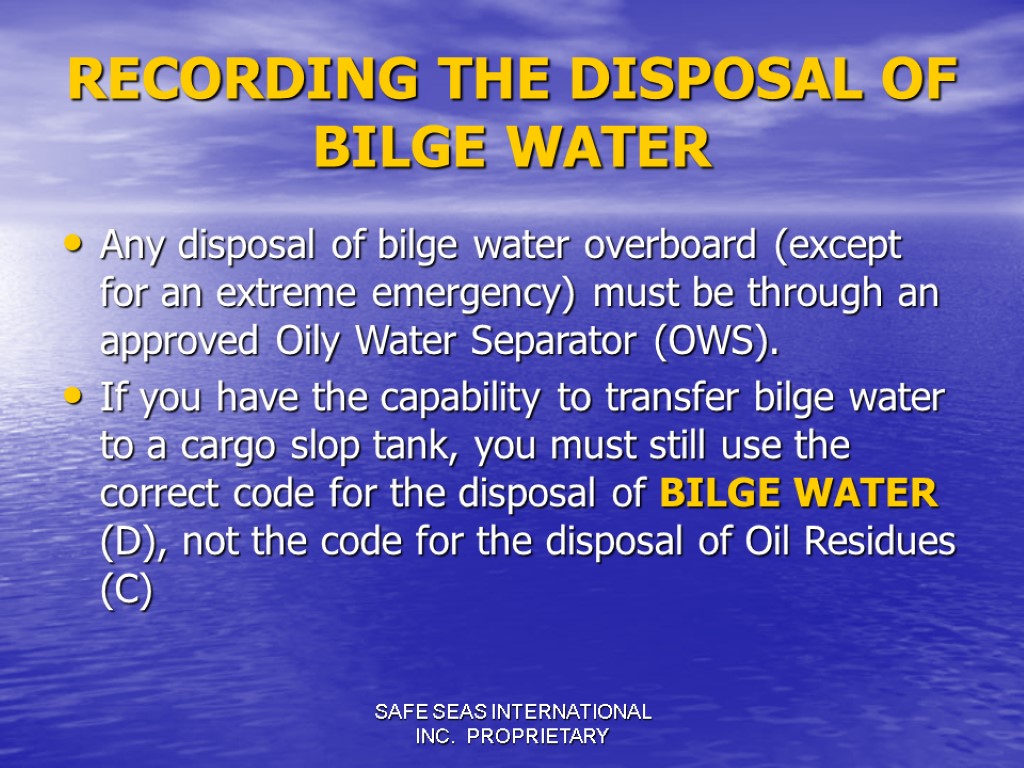
SAFE SEAS INTERNATIONAL INC. PROPRIETARY RECORDING THE DISPOSAL OF BILGE WATER Any disposal of bilge water overboard (except for an extreme emergency) must be through an approved Oily Water Separator (OWS). If you have the capability to transfer bilge water to a cargo slop tank, you must still use the correct code for the disposal of BILGE WATER (D), not the code for the disposal of Oil Residues (C)

SAFE SEAS INTERNATIONAL INC. PROPRIETARY On vessels with bilge water holding tanks, the recording of disposal of bilge water is a two step process. First, you must record the amount you pump from bilge wells to the tank, each and every time you pump water to the tank. Second, when it is time to pump your bilge holding tank ashore to a reception facility or another tank onboard (Cargo Slop Tank), you must record that transfer in the Oil Record Book. Don’t forget! EVERY ENTRY in the ORB must be signed by the Officer in charge of the operation!
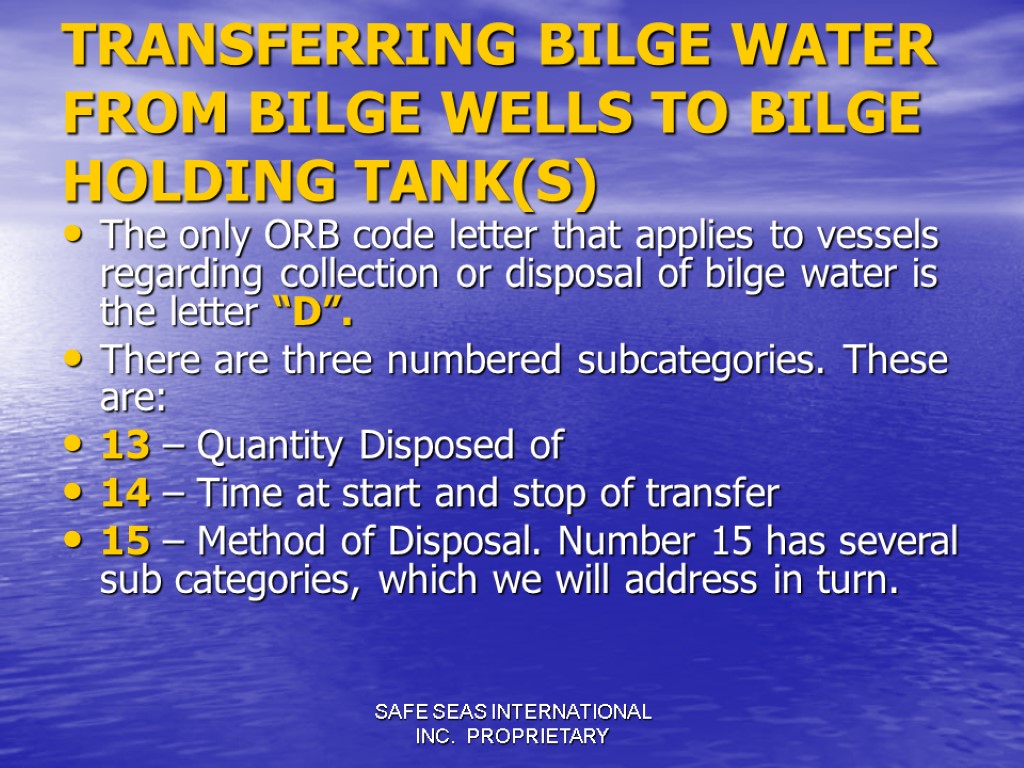
SAFE SEAS INTERNATIONAL INC. PROPRIETARY TRANSFERRING BILGE WATER FROM BILGE WELLS TO BILGE HOLDING TANK(S) The only ORB code letter that applies to vessels regarding collection or disposal of bilge water is the letter “D”. There are three numbered subcategories. These are: 13 – Quantity Disposed of 14 – Time at start and stop of transfer 15 – Method of Disposal. Number 15 has several sub categories, which we will address in turn.

SAFE SEAS INTERNATIONAL INC. PROPRIETARY The first numbered sub category is 13. This number refers to the quantity of water discharged. To ensure the accuracy of your ORB entry, sound the tanks before and after pumping bilges to the tank, to determine how much you have pumped. The math MUST add up! Although the ORB instructions do not say so, you SHOULD record how much is in the bilge holding tank at the finish of transfer. For example, the last entry about transferring bilge water to the bilge holding tank stated that there was 580 gallons in the tank. Now you transfer 100 gallons from the bilge well to the holding tank. You know you transferred 100 gallons because you sounded the holding tank before and after, right?

SAFE SEAS INTERNATIONAL INC. PROPRIETARY So your line entry for D – 13 will be: “Transferred 100 gallons” from bilge The second number subcategory is 14. This number is used to record the time of start and stop of the transfer operation. Pretty straight forward! Start transfer @ 0830 Finish @0930

SAFE SEAS INTERNATIONAL INC. PROPRIETARY The third and final numbered entry under code letter “D” is “15”. The code 15 tells where you pumped the bilge water 15.1 is used when pumping bilges overboard through an approved OWS. If you use your 15 PPM equipment, you must record the vessel’s position at the time of the start, and at the time of the finish, of each operation. Get this position from the Mate on watch.

SAFE SEAS INTERNATIONAL INC. PROPRIETARY 15.2 is the Code used for pumping bilge and waste water ashore to a reception facility (shore tank, tank truck, barge, etc.) 15.3 is the Code used for transferring Bilge water from the bilges to another tank or tanks aboard the vessel. On the next couple of pages, we’ll give sample entries for both transfer onboard and transfer ashore.

SAFE SEAS INTERNATIONAL INC. PROPRIETARY SAMPLE ENTRY – PUMPING FROM THE BILGE WELL TO THE BILGE HOLDING TANK “D” (Enter in the Code letter column of the ORB.) “13” Transfer 100 gallons from Bilge Well. (You know it’s 100 gallons because you sounded the tank before and after, right?) “14” Start at 0830 – Finish @ 0930 (DUH!) 15.3 From the bilge well to the bilge holding tank. 1,580 gallons remaining in the bilge holding tank. (or whatever you call the holding tank onboard your vessel.) SIGNED – Jimmy Joe, 2 A/E

SAFE SEAS INTERNATIONAL INC. PROPRIETARY SAMPLE ENTRY – PUMPING BILGE WATER ASHORE “D” (Enter in the Code letter column of the ORB.) “13” Transfer 1,580 gallons from Bilge Well. (You know it’s 1,580 gallons because you sounded the tank before and after, right?) “14” Start at 0830 – Finish @ 1030 (DUH!) “15.2” To Midnight Environmental Services tank truck at “Exact Location” facility. R.O.B (Remaining on board) in Bilge Holding Tank – 0 gallons. Signed, John Doe, C/E (C/E USUALLY supervises discharge ashore)

SAFE SEAS INTERNATIONAL INC. PROPRIETARY SAMPLE ENTRY – PUMPING OVERBOARD THOUGH AN APPROVED OWS. D 13 – XXX Gallons / Bbls/ cubic meters (whichever volume measurement you are using) discharged. 14 – Start 0830, finish – 0930 (duh!) 15.1 – through OWS, start position (get this from the Mate at 0830) – Finish Position (Get this from the Mate at 0930) Billy Bob, 3 A/E
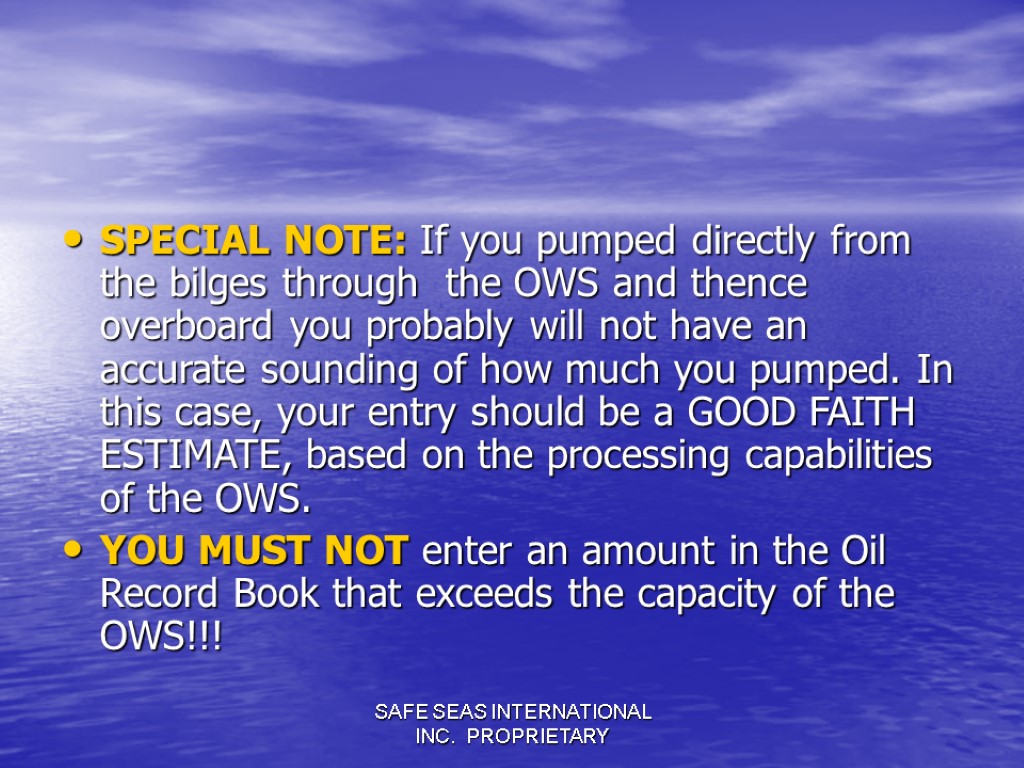
SAFE SEAS INTERNATIONAL INC. PROPRIETARY SPECIAL NOTE: If you pumped directly from the bilges through the OWS and thence overboard you probably will not have an accurate sounding of how much you pumped. In this case, your entry should be a GOOD FAITH ESTIMATE, based on the processing capabilities of the OWS. YOU MUST NOT enter an amount in the Oil Record Book that exceeds the capacity of the OWS!!!

SAFE SEAS INTERNATIONAL INC. PROPRIETARY A COUPLE OF GUIDANCE NOTES If you only have one tank on board for collecting both bilge water and waste oil, then: Use the code letter “D” when pumping bilges into the tank. Once the bilge water is IN the tank, and is co-mingled with collected waste oil, then it ALL becomes waste oil and / or oil residues, and Code letter “C” applies from then on. At that point, when it is time to pump it ashore, you should use code “C” 12.1, as described earlier.

SAFE SEAS INTERNATIONAL INC. PROPRIETARY SIGN EVERY ENTRY in the Oil Record Book. Do not “Initial”. SIGN!! If it leaves the vessel and goes ashore, GET A RECEIPT! If the facility does not / will not provide a receipt, LOG THIS FACT IN THE OIL RECORD BOOK! Cover your own butt! DO THE MATH! Make sure that as you collect oil / bilge water in the tank, the numbers add up, as well as when you pump it ashore.

SAFE SEAS INTERNATIONAL INC. PROPRIETARY “RIPPED FROM THE HEADLINES” Friday, November 17, 2006 The US Department of Justice said that a foreign ship operator was fined $400,000 (and assessed a $100,000 community service payment) for violation of the Act to Prevent Pollution from Ships (APPS) by failing to maintain an accurate oil record book. The company was also placed on probation for three years, during which time its ships will be banned from US ports and waters. The Department of Justice has requested the court to award half of the fine ($200,000) to the three crewmembers who reported the illegal dumping and falsified oil record book.

SAFE SEAS INTERNATIONAL INC. PROPRIETARY “RIPPED FROM THE HEADLINES” Wednesday, December 20, 2006 The U.S. Department of Justice said that a U.S. shipping company (OSG), agreed to plead guilty to deliberate oil pollution and presenting fraudulent oil record books to the U.S. Coast Guard. The company agreed to pay a $37m penalty, consisting of a $27.8m criminal fine and a $9.2 million community service payment. Additionally, the company will be on probation for three years, during which time it will comply with a court-imposed environmental compliance program. (That’s MILLION dollars, by the way) The C/E involved is facing CRIMINAL CHARGES.

SAFE SEAS INTERNATIONAL INC. PROPRIETARY PAY ATTENTION! If you like your job…. If you want to keep your job… If you don’t want your professional career DESTROYED…. If you like your freedom… If you don’t want to lose your freedom… If you don’t want to spend all of YOUR MONEY (the Company won’t help!!) on a lawyer to keep you out of jail…

SAFE SEAS INTERNATIONAL INC. PROPRIETARY TAKE THE TIME TO FILL OUT THE OIL RECORD BOOK… COMPLETELY! ACCURATELY! LEGIBLY! If you’re not sure…. RECORD IT! If you’re Not sure…..ASK!

SAFE SEAS INTERNATIONAL INC. PROPRIETARY If you make every effort to fill out the Oil Record Book as described above, you won’t find yourself in any trouble. If you try to be as accurate as you can be, you won’t find yourself in any trouble . The stories above relate to people who WILLFULLY and INTENTIONALLY ignored the law. Any Engineers who obey the law and make honest efforts to comply, HAVE NOTHING TO FEAR!!!!

SAFE SEAS INTERNATIONAL INC. PROPRIETARY HOWEVER……… If you ignore the requirements…… If you don’t pay attention to the details….. Then you’ll only have yourself to blame when the USCG or Port State Control comes calling with a request to “Have a look” at your Oil Record Book.
oil_record_book_entries_by_safe_seas.ppt
- Количество слайдов: 46

